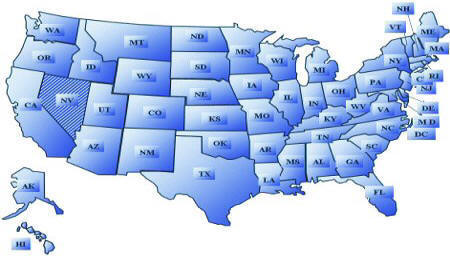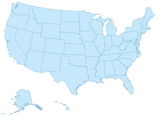Population
| Historical populations |
Census
year |
Population |
|
| 1850 |
92,597 |
| 1860 |
379,994 |
| 1870 |
560,247 |
| 1880 |
864,694 |
| 1890 |
1,213,398 |
| 1900 |
1,485,053 |
| 1910 |
2,377,549 |
| 1920 |
3,426,861 |
| 1930 |
5,677,251 |
| 1940 |
6,907,387 |
| 1950 |
10,586,223 |
| 1960 |
15,717,204 |
| 1970 |
19,953,134 |
| 1980 |
23,667,902 |
| 1990 |
29,760,021 |
|
2000 |
33,871,648 |
As of 2005, California has an estimated population of 36,132,147, which is an
increase of 290,109, or 0.8%, from the prior year and an increase of 2,260,494,
or 6.7%, since the year 2000, making California the 13th fastest-growing state
(after Nevada, Arizona, Florida, Georgia, Utah, Idaho, Texas, Colorado, North
Carolina, Delaware, Virginia, and Washington State). This includes a natural
increase since the last census of 1,557,112 people (that is 2,781,539 births
minus 1,224,427 deaths) and an increase due to net migration of 751,419 people
into the state. Immigration from outside the United States resulted in a net
increase of 1,415,879 people, and migration within the country produced a net
loss of 664,460 people.
California is the most populous state-more than 12 percent of Americans live
in the state. California's population is larger than all but 33 countries. About
two million more people live in California than in all of
Canada.
Racial and Ancestral Makeup
The Census Bureau considers
race and Hispanic origin to be two separate categories. Hispanics must not
only select "Hispanic"; they must also select a race such as White or Asian, or,
simply "some other race." This makes interpreting Census data difficult. Thus,
for the sake of simplicity, the data below does consider Hispanic origin to be
its own category. It therefore shows only non-Hispanic members of each group:
non-Hispanic Whites, non-Hispanic Eskimos, non-Hispanic people of two or more
races, etc. For more information on race and the Census, see
here.
California lacks a majority
ethnic group. It is the third minority-majority state, after
Hawaii and
New Mexico. Non-Hispanic
Whites are still the largest group, but are no longer a majority of the
population due to high levels of immigration in recent years.
Hispanics make up over one-third of the population; in order, other groups
are
Asians,
Blacks, and
Native Americans.
Because of high levels of immigration from Latin America, especially Mexico,
and higher birth rates among the Hispanic population, Hispanics are predicted to
become a majority in the state around 2040. California has the second-largest
Asian population (percentage-wise) of any state, Hawaii having the largest.
The largest ancestries in California are Mexican (25%),
Filipino, German, Irish, Italian, and Asian. Mexicans and
Chicanos predominate in Southern California, the Central Valley, Salinas,
and parts of the San Francisco Bay area. Irish and German ancestries are
dominant in the eastern Sierra Nevada, the far north, and the North Coast.
Italians are clustered near San Fransisco Bay and the wine country surrounding
it. San Francisco has the greatest concentration of Asians in the continental
United States, with Chinese numerous in San Francisco, Alameda, and Santa Clara
counties and Filipinos particularly numerous in San Mateo county.


